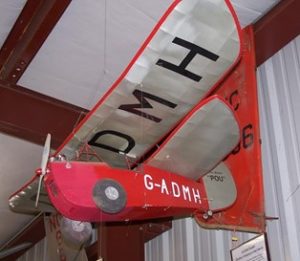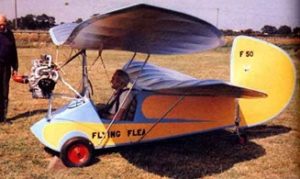 Mignet Pou-du-Ciel Model (Literally “The Flying Flea ”or “Louse of the Sky”)
The Mignet Pou-du-Ciel model in the museum is a representation of a family of aircraft designed by Frenchman Henri Mignet. The odd name comes from the French nickname for the Ford Model T automobile, “Pou de la Route” meaning “Louse of the Road” because Henry Ford’s economy car was so common and initially only came in the color black. Henri Mignet dreamed of creating a Model T of the air, an airplane for the common man, hence “Pou du Ciel.” In the English translation, the term became “Flying Flea.”
Originally the description was applied only to his model HM.14, but the name began to be applied to the entire family of aircraft of a similar configuration designed by Mignet and others. Between 1920 and 1928, Mignet built various prototypes from the HM.1 to the HM.8, a monoplane that was the first of his designs that really flew. In 1933, Mignet successfully flew for the first time in his HM.14, the original flying flea, and publicly demonstrated it. In 1934, he published the plans and the building instructions in his book, Le Sport de l’Air. In 1935, it was translated into English and circulated in Practical Mechanics in the USA, prompting hundreds of people around the world to build their own Flying Fleas.
Mignet’s original HM.14 was powered by a 17 HP Aubier-Dunne two-stroke motorcycle engine. It had a wingspan of 19.5 feet, a length of 11.5 feet, and a gross weight of 450 pounds. It had a usable speed range of 25-62 MPH. Mignet designed the aircraft intentionally simple. The Flying Flea was essentially a highly staggered biplane.
Mignet Pou-du-Ciel Model (Literally “The Flying Flea ”or “Louse of the Sky”)
The Mignet Pou-du-Ciel model in the museum is a representation of a family of aircraft designed by Frenchman Henri Mignet. The odd name comes from the French nickname for the Ford Model T automobile, “Pou de la Route” meaning “Louse of the Road” because Henry Ford’s economy car was so common and initially only came in the color black. Henri Mignet dreamed of creating a Model T of the air, an airplane for the common man, hence “Pou du Ciel.” In the English translation, the term became “Flying Flea.”
Originally the description was applied only to his model HM.14, but the name began to be applied to the entire family of aircraft of a similar configuration designed by Mignet and others. Between 1920 and 1928, Mignet built various prototypes from the HM.1 to the HM.8, a monoplane that was the first of his designs that really flew. In 1933, Mignet successfully flew for the first time in his HM.14, the original flying flea, and publicly demonstrated it. In 1934, he published the plans and the building instructions in his book, Le Sport de l’Air. In 1935, it was translated into English and circulated in Practical Mechanics in the USA, prompting hundreds of people around the world to build their own Flying Fleas.
Mignet’s original HM.14 was powered by a 17 HP Aubier-Dunne two-stroke motorcycle engine. It had a wingspan of 19.5 feet, a length of 11.5 feet, and a gross weight of 450 pounds. It had a usable speed range of 25-62 MPH. Mignet designed the aircraft intentionally simple. The Flying Flea was essentially a highly staggered biplane.
The “Flying Flea”
 The aircraft had two-axis flight controls. With a standard control stick fore-and-aft movement controlling the front wing’s angle of attack, increasing and decreasing the lift of the wing. Because the front wing was located forward of the center of gravity, this allowed the nose to pitch up and down. Side-to-side movement of the stick controlled the large rudder. This produced a rolling motion because the wings both had a substantial dihedral, through yaw-roll coupling. The rudder had to be quite large not only to produce adequate roll but also because the fuselage was very short, reducing the leverage of the rudder.
Because the Flying Flea was a two-axis aircraft, it could not be taken off or landed in substantial crosswinds. This was not a big issue because at that time aircraft were usually flown from large open fields allowing all takeoffs and landings into the wind! Mignet claimed that anyone who could build a packing crate and drive a car could fly a Flying Flea!
Despite the initial popularity of the design, thanks in no small part to the passionate enthusiasm of Mignet himself, the original HM.14 revealed design flaws that could lead to an unrecoverable and often fatal dive under certain conditions. When the front wing was put in a high angle of attack for climbing, the flow of air deflected by the front wing radically increased the flow of air over the upper surface of the rear wing greatly increasing the rear wing’s lift and causing the nose of the aircraft to drop. Instinctively the pilot would pull back more on the control stick which aggravated the situation.
By extensive wind tunnel testing, this condition was corrected and corrections made to the design. Unfortunately, the wave of bad publicity created by the crashes dogged Mignet for the rest of his life and continues to be associated with the design today despite the fact that the basic Mignet configuration has proven to be safe in hundreds of successful homebuilt aircraft and factory-built microlights.
Source: Excerpts from en.wikipedia.org
The aircraft had two-axis flight controls. With a standard control stick fore-and-aft movement controlling the front wing’s angle of attack, increasing and decreasing the lift of the wing. Because the front wing was located forward of the center of gravity, this allowed the nose to pitch up and down. Side-to-side movement of the stick controlled the large rudder. This produced a rolling motion because the wings both had a substantial dihedral, through yaw-roll coupling. The rudder had to be quite large not only to produce adequate roll but also because the fuselage was very short, reducing the leverage of the rudder.
Because the Flying Flea was a two-axis aircraft, it could not be taken off or landed in substantial crosswinds. This was not a big issue because at that time aircraft were usually flown from large open fields allowing all takeoffs and landings into the wind! Mignet claimed that anyone who could build a packing crate and drive a car could fly a Flying Flea!
Despite the initial popularity of the design, thanks in no small part to the passionate enthusiasm of Mignet himself, the original HM.14 revealed design flaws that could lead to an unrecoverable and often fatal dive under certain conditions. When the front wing was put in a high angle of attack for climbing, the flow of air deflected by the front wing radically increased the flow of air over the upper surface of the rear wing greatly increasing the rear wing’s lift and causing the nose of the aircraft to drop. Instinctively the pilot would pull back more on the control stick which aggravated the situation.
By extensive wind tunnel testing, this condition was corrected and corrections made to the design. Unfortunately, the wave of bad publicity created by the crashes dogged Mignet for the rest of his life and continues to be associated with the design today despite the fact that the basic Mignet configuration has proven to be safe in hundreds of successful homebuilt aircraft and factory-built microlights.
Source: Excerpts from en.wikipedia.org
